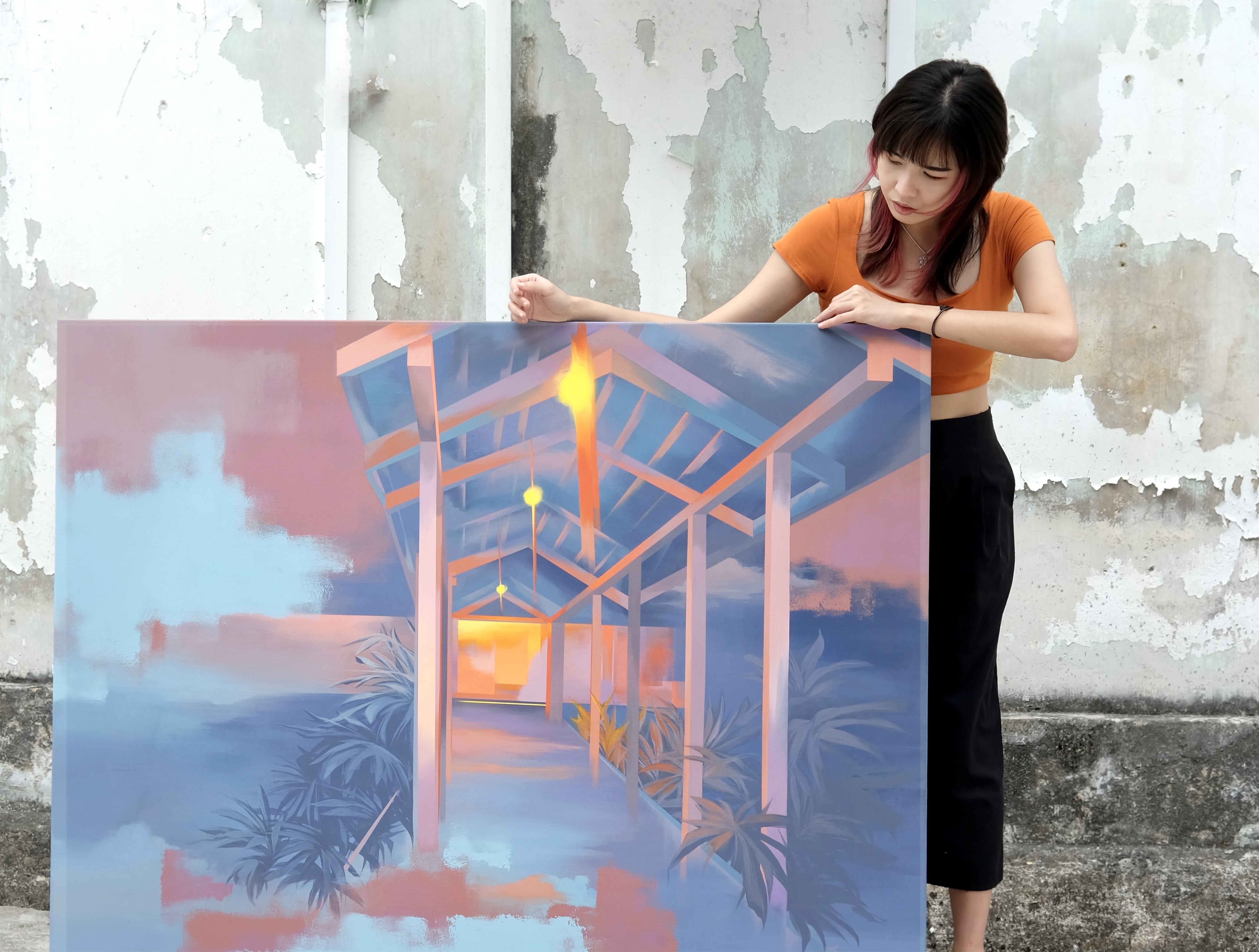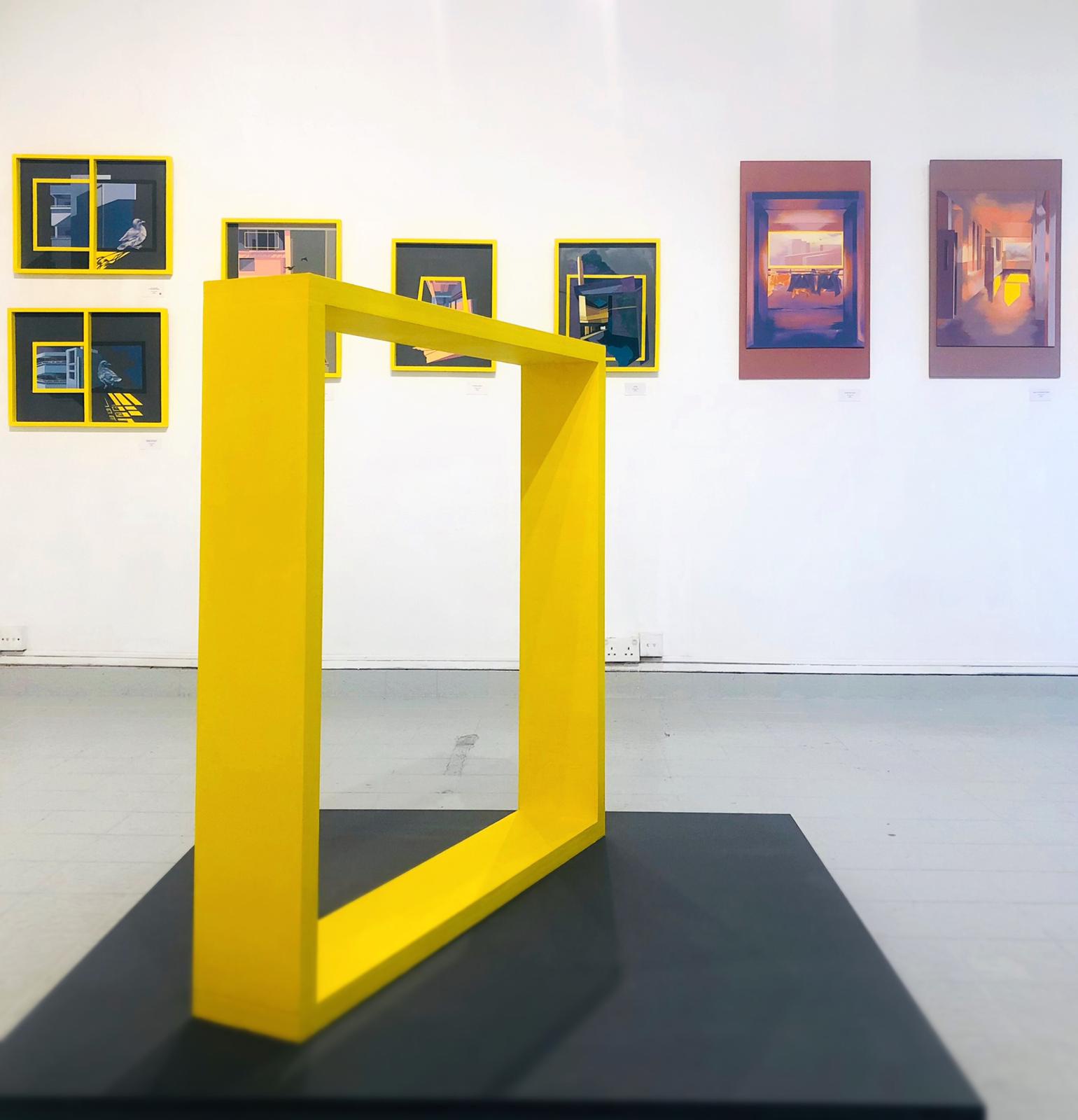
Hero Image: Shen with her painting, Covered Walkway in Twilight (2020). (Image credit: Cuturi Gallery and Shen Jiaqi)
Living in Singapore—a country that prides itself in its constant progress—it makes perfect sense that artist Shen Jiaqi’s personal experiences with the city-state’s constant changes and systems of social governance inform her oeuvre.
Shen’s works are nothing short of eye-catching as they depict everyday scenes in Singapore’s urban environment, masterfully draped in vibrant yet muted tones that lend an air of mystery. There is a sense of serenity to these quotidian scenes as many of her paintings remain devoid of people and instead focus on familiar public spaces such as void decks, stairwells, and window views of Singapore’s HDB (Housing Development Board) flats.

Something Better (2021), acrylic on canvas, by Shen Jiaqi (Image credit: Cuturi Gallery and Shen Jiaqi)
At her most recent exhibition ‘Ever-Were’ at Cuturi Gallery, I found engaging with Shen’s paintings to be a nostalgic and emotionally intimate affair. While her compositions rarely hint at a particular neighbourhood or district, the familiarity of such everyday, common spaces evokes personal experiences and invites viewers to reflect on their associations with the urban landscape around them.
B-side speaks to Shen about her inspirations, relationship with Singapore, creative processes, and what she hopes viewers take away from her work.
Your paintings feature public spaces, housing estates, and communal spaces. Why do you think it is important to showcase spaces from everyday lived realities in Singapore?
Space is such a precious commodity in Singapore, and as a result, we have such a unique relationship with it. We associate status and emotional well-being with the scale and location of both private and public spaces. The demarcation of home territories has always been a challenge here due to spatial limitations and the element of transience is always present for communal spaces. I hope that through familiar images of public spaces, we can uncover how this perennial cycle of transformation affects the formation of certain social relationships and shared experiences here.
Each work feels deeply intimate and poignant. In the way, it meditates on places that continue to exist and change. Can you elaborate on how your practice has helped you develop and define your relationship with places in Singapore (be it with places that still exist or don’t exist anymore)?
Through my practice as a visual artist, I am particularly keen on exploring how colour combinations and familiar tones remind us of certain routines and the behavioural patterns we engage in within the urban environment. Colours that remind us of social boundaries are ever-present. By juxtaposing these colours with muted tones and gradients, I want to emphasise how we adjust our emotional states and expectations to live in tandem with these restrictions.
Through my work, I uncover certain subconscious connotations I have with certain places and find a similar connection with different individuals who also view these places with a certain emotional significance.
Trivial Pursuits (2020), acrylic on canvas, by Shen Jiaqi. (Image credit: Cuturi Gallery and Shen Jiaqi)
Is there anything in particular about a space that draws you to it, considering you depict ordinary places?
The spaces I chose for my most recent series are areas around public housing estates that have a special place in my memories. They also hold the collective memory of many Singaporeans who encounter them daily. We attach a certain significance to such spaces on a personal level due to routine and the accumulation of memory, and therefore there is an unspoken attachment to areas that we associate with our homes.
Are there any other cities or places in Singapore you would consider portraying in your works? If there are, what would they be and why?
Yes, I am keen to visit other countries once we are able to travel. I hope to research how different communities define their spaces and how such spaces offer their inhabitants a sense of comfort and belonging.
In Singapore, I am currently gathering photographs of places that are constantly being renewed and upheaved. These places contain layers of memory from previous inhabitants and their development symbolises the urban city’s state of perennial change. Such changes indicate the desire for a “better” future; an anticipated fictional space that can better fulfil the wants and needs of its community.
I am keen to investigate how colours and the medium of paint encapsulate the ephemeral qualities and collective familiarity of our modern environment, and how significant an individual’s narrative might be within such spaces.
What is your process for composing each work, seeing that the locations look and feel extremely familiar?
I usually walk around a random location on different days at various times to observe the pattern of human behaviour in these spaces. I imagine these spaces to contain certain narratives within them and plan the colours that I feel suit the location. The places that I explore also depend on the particular concept I intend to work on.

Shen’s first solo show, Comfort Zones, at Coda Culture in 2020. (Image Credit: Shen Jiaqi)
Your practice spans painting and installation. How do they complement each other and what does each specific medium bring to your practice?
I enjoy working with a combination of different materials in every work and the concept of the series dictates the materials that I eventually incorporate in each piece. I usually like to juxtapose forms and materials to create tension through the duality of materials, and how certain materials and painting techniques represent the ephemeral and transitional nature of urban planning and territorial boundaries.
Most of my works depict familiar places and each visitor has varied experiences of them. I focus on how the individual’s prior experiences and memories of a place add nostalgia and meaning when viewing a painting of a certain place.
I also enjoy exploring how different colour gradients evoke a sense of fleetingness and eventual change, so you can find my use of colour to be quite prevalent in both my paintings and installation pieces. With painting being a 2D medium presenting an image, I tend to subtract what is unnecessary for my concept.
Whereas for installation or 3D pieces, I like to create fictional spaces or the likelihood of possible spaces, as visitors will experience the installation physically.

Kept the first for another day (2020), Acrylic on Panel, by Shen Jiaqi. (Image credit: Cuturi Gallery and Shen Jiaqi)
Yellow lines and boundaries signifying social restrictions are present in your works. How did you go about incorporating such visual symbols into your work, and do you think their presence in everyday Singapore life affects how the audience understand your work?
Using yellow lines to symbolise conformity and restraint was an idea that occurred to me when I was near an ATM. I noticed the lines painted to demarcate the space we should stand in while using ATMs are sometimes left on the ground, even after they has been shifted to another location.
I decided to use yellow lines to represent behaviour that has been subconsciously conditioned by societal expectations and routines; behaviour that embodies our experiences in Singapore even if we physically remove ourselves from the environment. As I developed my series, these lines became more than just regulators to me: they also protect the peace and comfort inhabitants expect within such boundaries.
I liken this to a sort of willing containment; a choice that many take to protect what they consider familiar and comfortable. Currently, for my most recent ongoing series, I am utilising the bright orange used for construction barricades to represent how our society is in a constant state of upheaval and change and how it can affect our reactions to anticipation and loss.
Finally, is there anything you hope viewers take away from your work?
I am always grateful when my work resonates with others who have lived experiences of Singapore or environments that carry similar themes of urban containment and restraint. I hope for my pieces to be a reminder of each individual’s emotional resilience and the realisation that there is a communal desire for sanctuary and comfort.

